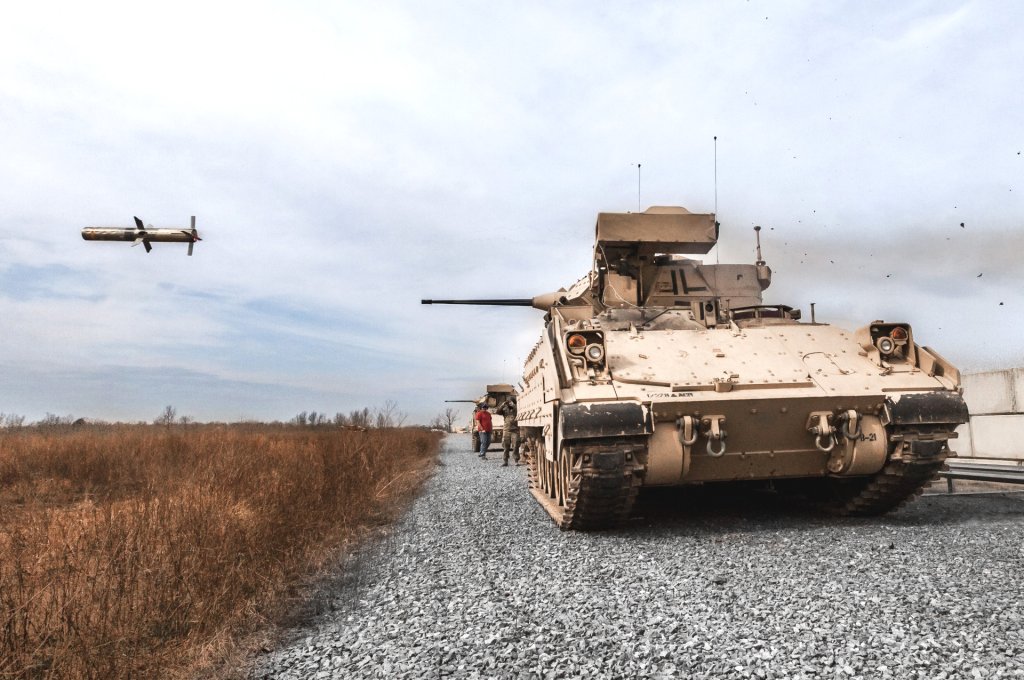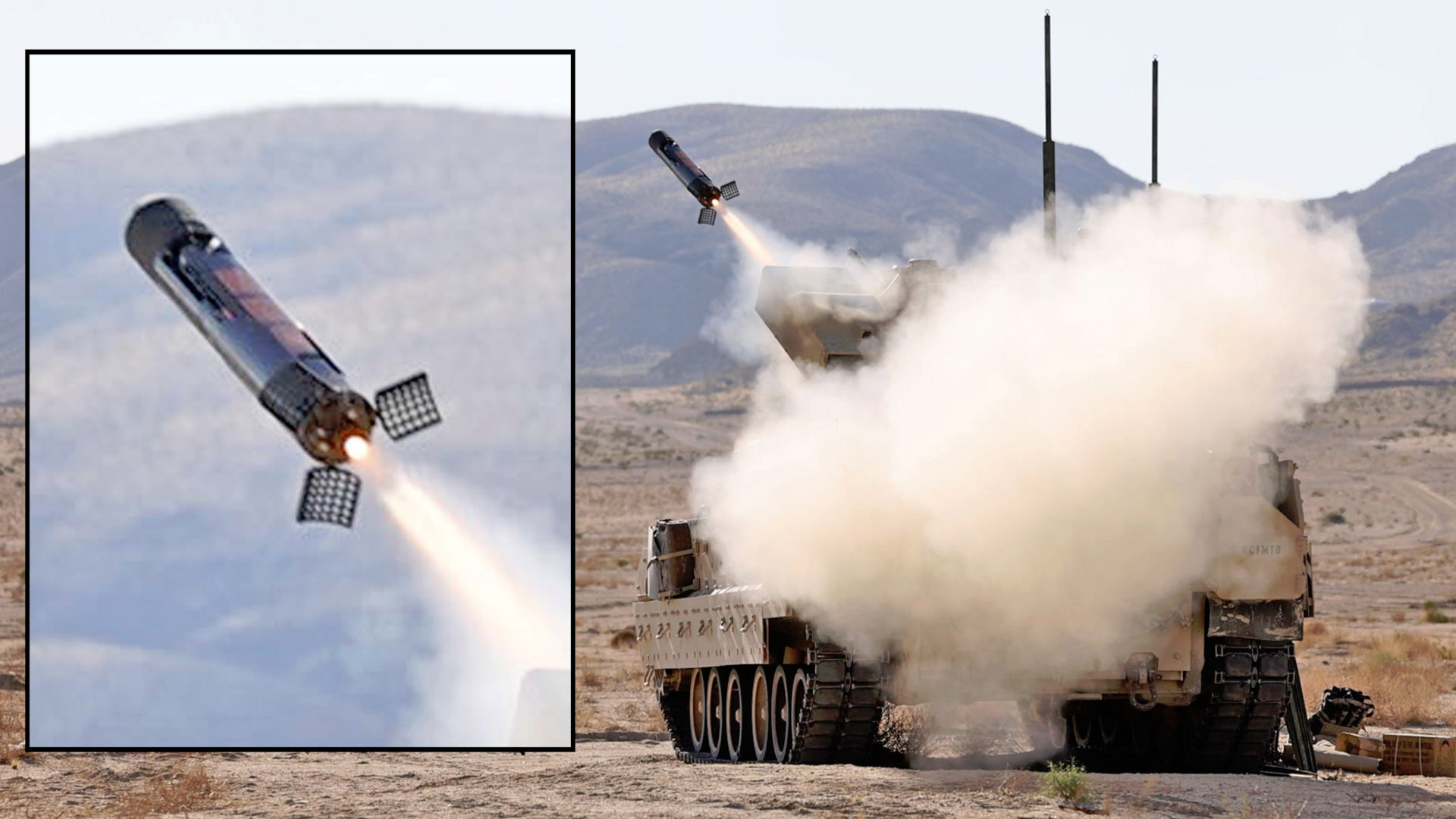An unknown weapon seen being fired from a U.S. Bradley Fighting Vehicle’s BGM-71 TOW anti-tank guided missile launcher at a major test event earlier this year has now been identified. It is a Raytheon Coyote LE SR uncrewed aerial system, which can be configured for surveillance and reconnaissance, electronic warfare, and signal relay missions, and as a kamikaze drone. TWZ was first to report on what the Army referred to initially only as a “670.”
Raytheon (now formally named RTX) confirmed to TWZ that the picture the Army previously released shows a Bradley launching a Coyote LE SR (Launched Effect, Short-Range) at the Project Convergence-Capstone 5 (PC-C5) event at Fort Irwin, California, back in March 2025. The company also confirmed that the Bradley’s TOW launcher did not have to be modified for the demonstration, which the Army funded. Since 2020, the service has been using Project Convergence events to test, integrate, and network together new weapon systems and other capabilities in ever-more operationally relevant scenarios.

In March, Raytheon separately announced a successful aerial test launch of a Coyote LE SR from a Bell 407 helicopter at the privately owned and operated Nine Mile Training Center in Texas. The company has also teased potential naval applications for the newest member of the Coyote family.

Originally known as Coyote Block 3, the Coyote LE SR is derived from the combat-proven jet-powered Coyote Block 2 counter-drone interceptor. Both the Coyote LE SR and Coyote Block 2 have more missile-like configurations compared to the original Coyote drone (also now known as the Coyote Block 1) with its pop-out wings and tail fins, as well as its electric motor-driven pusher propeller.


Coyote LE SR itself differs notably from the Block 2 design, dispensing with the latter’s four pop-out tail fins and corresponding strakes along the body in favor of three pop-out grid fins at the rear. None of the pictures to date of the Coyote LE SR show additional control surfaces, but there are open gaps visible toward the front end of the body where pop-out wings could deploy from.

“At this time, we cannot provide any specifications on Coyote LE variants outside of the capabilities being platform and payload-agnostic,” Raytheon told TWZ when asked for more information about the LE SR’s capabilities. “The Coyote LE SR supports a variety of missions that include: reconnaissance, surveillance, and target acquisition; electronic warfare, precision strike, [and] communications.”
In addition, “the Coyote LE SR is recoverable, can be refurbished, and reused,” according to Raytheon.
Whether or not Coyote LE SR might also be configurable for anti-air use is unclear. Raytheon had said in the past that it is focusing first on intelligence, surveillance, reconnaissance (ISR) type missions for the Coyote LE SR. What, if any, other Coyote LE-series variants are in development now, or might exist already, is unknown.
For the Army’s Bradley Fighting Vehicles, being able to launch Coyote LE SRs from their TOW launchers offers new indirect fire, electronic warfare, and surveillance and reconnaissance capabilities, all likely over extended ranges. These would all be major boons for the Army’s heavy armored formations.

Leveraging the proven Coyote Block 2 design to produce a more multi-purpose uncrewed aerial system that can perform an array of missions and be fired from a variety of platforms in the air and down below fits into the Army’s broader ‘launched effects’ plan, as well. The service currently uses this term as a catch-all for a planned ‘system of systems’ consisting of multiple tiers of uncrewed platforms capable of performing ISR and electronic warfare tasks, as well as being employed as decoys and loitering munitions, and that can be employed from aerial, ground, and potentially even maritime platforms.
The Army’s goals for its future family of launched effects are to extend the sensor reach of its forces in the air and on ground, as well as the range at which they can provide non-kinetic effects like electronic warfare jamming and launch kinetic attacks, all while reducing vulnerability to the enemy. Groups of launched effects in various configurations, including types configured as signal relays, networked together into a swarm could simultaneously perform an array of missions across a broad area.
The video below offers a very general overview of the Army’s vision for its future family of launched effects.

Coyote LE SR, specifically, now brings the significant added advantage of being able to be fired from unmodified TOW launchers. This is something TWZ highlighted could be the case in our initial reporting on the picture of the Bradley launch at PC-C5. In addition to the Bradley, the Army currently has Stryker light armored vehicles and Humvees in service armed with TOW missiles, as well as tripod launchers for use by dismounted units.


In recent years, the Army has been exploring options for a next-generation Close Combat Missile System-Heavy (CCMS-H) to succeed the BGM-71 family that offers greater range and speed, as well as new networking capabilities, but in a form factor that can use existing launchers. The Army uses the term CCMS-H to refer to its current TOW missiles, the latest versions of which have already replaced the original wire-guided configuration with a wireless datalink.

In addition, the U.S. Marine Corps has TOW-armed anti-tank versions of the LAV-25 light armored vehicle, along with launchers on Humvees and tripods. The Marines are also now in the process of acquiring their own multi-tiered family of loitering munitions. Variants of the TOW missile are in widespread use globally, arming an array of other armored and unarmored ground vehicles.

TOW’s use has been steadily declining as an air-launched weapon for helicopters, but it might be possible to reuse those launchers with Coyote LE SR. The aforementioned Bell 407 helicopter test-fire earlier this year was conducted using a Modular Effects Launcher, a new launch rack the Army has been developing for helicopters to fire launched effects and various missiles.


“The aircraft was less of the focus, and more of being able to use the Modular Effects Launcher, because that’s one of the key needs for the [U.S.] Army,” Brian Burton, vice president of Precision Fires & Maneuver at Raytheon, told Jane’s in March. “One of the things that’s important to us is to be able to launch off of multiple platforms, and be able to [launch from] air, ground, and sea.”
Raytheon is already making clear progress in expanding the number of potential launch options for Coyote LE SR, including the Bradley and other platforms with TOW missile launchers. As that testing continues, other details about the newest member of the Coyote family may begin to emerge.
Contact the author: joe@twz.com
